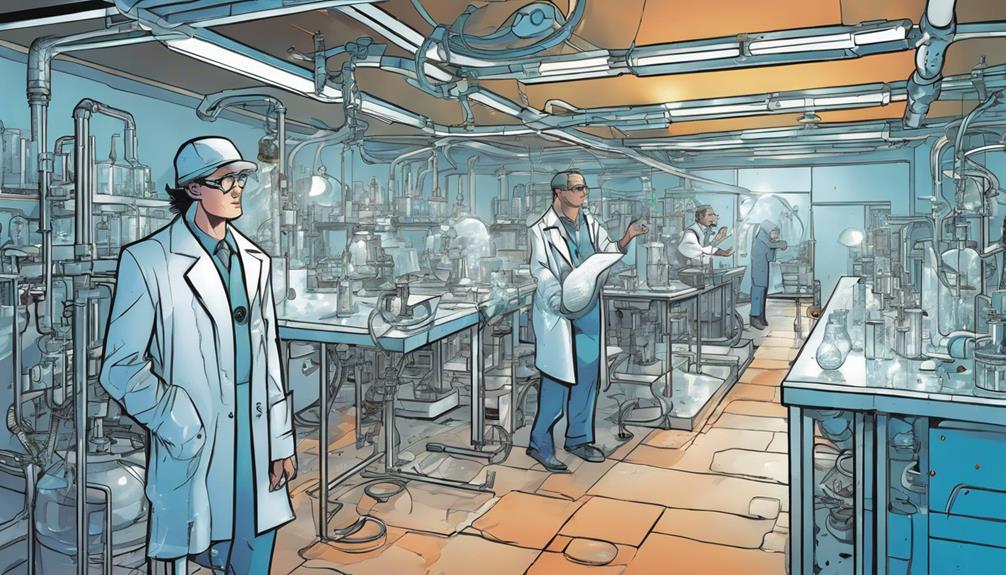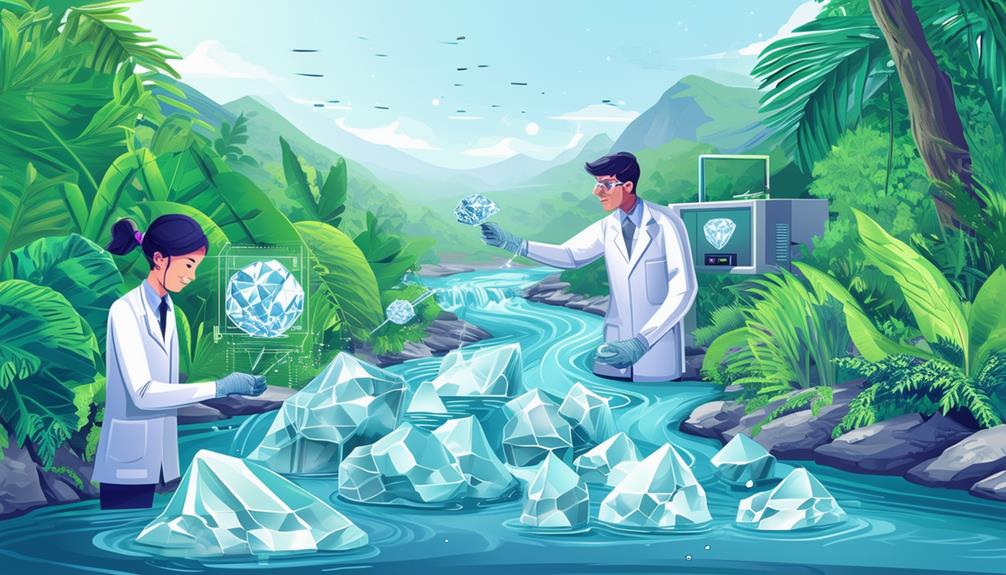Article Contents
The creation of lab diamonds significantly saves water compared to traditional diamond mining methods. Traditional mining requires approximately 126 gallons of water per carat for processes such as washing, sorting, and extracting diamonds, which not only uses large amounts of water but also poses risks to the environment.
Conversely, the production of lab-grown diamonds utilises advanced water management systems that include recycling technologies, thereby significantly reducing the reliance on freshwater sources. This method demonstrates a commitment to environmental stewardship by promoting sustainable practices within the jewellery industry.
Further exploration into these technologies reveals their potential to transform the landscape of sustainable luxury.
Key Points
- Lab-created diamonds utilise closed-loop systems that recycle water, substantially reducing the need for fresh water.
- Innovative technologies in labs enhance water efficiency, thereby decreasing reliance on natural water sources.
- By recycling water, labs minimise the impact on local water reserves, avoiding the need for extensive water extraction.
- Environmental regulations are strictly followed in lab settings, promoting effective water management and reducing pollution.
- The process of creating diamonds in a lab has a much lower water footprint than traditional diamond mining methods.
Traditional Diamond Mining Process
The traditional diamond mining process significantly impacts local water resources and ecosystems. This method, essential for extracting and purifying diamonds, requires large amounts of water to wash the mined ore and to separate the diamonds, often employing hydraulic mining techniques. These practices not only exhaust local water supplies but also lead to environmental harm, including water pollution and disruption of aquatic ecosystems.
The need for water conservation in these areas is critical. Implementing advanced, water-efficient mining techniques can help reduce the ecological impact of diamond mining. By adopting sustainable technologies, the industry can decrease its environmental footprint, addressing both ecological and economic concerns. Water scarcity poses a real threat to the sustainability of mining operations and the well-being of local communities.
Responsible mining practices are crucial for the sustainability of natural resources and for ensuring the well-being of future generations. Moving towards more sustainable practices helps protect ecosystems and improves quality of life, making the allure of diamonds compatible with environmental preservation.
Water Consumption in Mining
Analysing the water usage in diamond mining reveals that traditional extraction methods consume substantial amounts of water, leading to considerable ecological harm and exacerbating water shortages.
In contrast, artificial diamond production utilises water-efficient technologies that reduce environmental impact, offering a more sustainable option.
Mining Water Usage Overview
Diamond mining notably requires up to 126 gallons of water per carat, significantly affecting water supplies in various areas. This substantial usage highlights the critical need for efficient water conservation and management strategies within the sector.
- Washing and Processing: The extensive use of water in the washing, sorting, and processing of diamonds significantly increases the industry's water demand.
- Dust Suppression: Both open-pit and underground mining operations use large volumes of water to suppress dust, which is essential for environmental protection and worker safety.
- Machinery Cooling: Cooling heavy machinery in mining operations also demands a considerable amount of water, adding to the industry's overall water footprint.
Environmental Impact Assessment
Given the substantial water usage in diamond mining, it is crucial to evaluate its environmental impact. The assessment includes a thorough analysis of the extensive water used in traditional diamond extraction processes. Such heavy water consumption depletes local water supplies and adversely impacts nearby ecosystems.
The assessment reveals that conventional mining methods can cause significant environmental harm through water pollution and habitat destruction. In contrast, the production of lab-grown diamonds is noted for its lesser ecological impact, promoting sustainability by reducing environmental footprints.
These findings emphasise the importance of adopting more sustainable mining technologies that conserve water and preserve natural resources, advocating for a shift towards environmentally responsible practices within the diamond industry.
Comparison of Sustainable Alternatives
The comparison between the water consumption of traditional mining methods and lab-created diamond production reveals a significant decrease in environmental impact. Lab diamonds not only represent a commitment to aesthetic appeal but also to sustainable practices and efficient resource management.
- Reduced Water Usage: Traditional mining consumes approximately 126 gallons of water per carat, whereas lab-grown diamonds require significantly less water, supporting water conservation efforts.
- Enhanced Resource Stewardship: The lower water requirements of lab diamond production facilities highlight their dedication to sustainable resource usage.
- Protection of Water Quality: The reduced water usage in lab diamond production helps maintain better water quality by reducing the potential for contaminated runoff.
This comparison highlights the choice for a more sustainable and environmentally friendly option in jewellery production.
Lab Diamond Production Techniques
Lab diamond production techniques meticulously control the growth process to maximise efficiency and minimise resource usage. Advanced technologies used in these systems regulate every aspect of diamond synthesis, from temperature to atmospheric pressure, ensuring the production of high-quality gems while conserving water, an approach that aligns with contemporary sustainable practices.
Key to this efficiency is the use of growth control mechanisms that monitor and adjust the conditions under which lab diamonds are formed. This precise management helps reduce water consumption, a significant issue in traditional diamond mining methods.
Additionally, the integration of water recycling systems in lab diamond production exemplifies the commitment to sustainability. These closed-loop systems recycle water within the production process, significantly cutting down on the demand for fresh water. This method is not only environmentally friendly but also reduces costs, making it an advantageous alternative in the resource-heavy field of gemstone extraction.
Thus, through these innovative methods, lab diamond production not only meets but also enhances the standards of water conservation, demonstrating how modern technology can lead to more sustainable practices in the luxury industries.
Water Efficiency in Laboratories

In the production of lab-grown diamonds, efficient water usage is essential. Implementing advanced cooling technologies not only boosts operational efficiency but also significantly minimises water consumption.
Furthermore, the adoption of water recycling systems in these facilities demonstrates a strong commitment to sustainability. This practice helps conserve valuable water resources without compromising the quality of the diamonds produced.
Optimised Cooling Processes
Optimised cooling processes greatly enhance water efficiency in laboratories, which is essential for the sustainable production of lab-grown diamonds. These processes help to reduce waste and make resource usage more efficient, in line with principles of sustainable resource management.
- Closed-loop systems: These systems recycle and reuse water during the process, significantly reducing the need for fresh water.
- Advanced cooling technologies: These technologies offer precise temperature control, decreasing the amount of water required and how often it is needed.
- Precise control mechanisms: These mechanisms guarantee the best use of water, preventing excessive use and promoting environmental sustainability.
Recycled Water Use
Recycled water use in diamond laboratories significantly reduces dependence on fresh water sources, reinforcing a commitment to environmental sustainability. The implementation of sophisticated water recycling systems ensures efficient water use, helping to conserve this vital resource. Such practices are essential for maintaining ecological balance and serve as a model for effective water management.
| Feature | Benefit | Impact |
|---|---|---|
| Closed-loop systems | Minimises waste | Improves sustainability |
| Water recycling | Lowers reliance on fresh water | Enhances environmental health |
| Conservation methods | Optimises water usage | Reduces ecological impact |
Comparing Water Usage
Lab-grown diamonds significantly reduce water usage, consuming over 90% less water compared to traditional mining. This substantial reduction is achieved through advanced water-saving technologies and effective conservation strategies integral to the manufacturing process of lab diamonds. These methods not only conserve water but also improve resource management across the industry.
- Efficiency Measures: In laboratory environments, water usage is optimised through cutting-edge technologies that substantially decrease the dependency on freshwater. This is vital for reducing the environmental impact and preserving crucial water resources.
- Recycling and Waste Management: The water utilised in lab diamond production is frequently recycled. This practice lessens the need for fresh water sources and lowers the water footprint of lab-grown diamonds.
- Strict Environmental Compliance: Facilities producing lab-grown diamonds comply with strict environmental regulations that help prevent water pollution, thereby maintaining water quality and promoting sustainable production practices.
These approaches demonstrate that lab-grown diamonds are not only aesthetically pleasing and innovative but also represent a commitment to environmental responsibility and the reduction of resource-intensive processes. By opting for lab-grown diamonds, consumers endorse a model where luxury and environmental sustainability can coexist.
Environmental Benefits of Lab Diamonds

Lab-created diamonds offer significant environmental advantages, particularly in terms of water conservation and reducing water pollution. These diamonds are made using advanced technological techniques that require far less water than traditional mining methods, highlighting their contribution to sustainable practices. By using resources efficiently, lab-created diamonds help to preserve essential water sources and lessen the environmental impact of diamond production.
In the controlled environments of diamond laboratories, water pollution is almost entirely eliminated. The meticulous management of these spaces enables effective recycling and responsible waste disposal, further enhancing the sustainability of lab-grown diamonds. Consumers who choose these diamonds are therefore backing water conservation efforts and endorsing environmentally conscious practices.
Opting for lab-grown diamonds combines the luxury of exquisite jewellery with environmental stewardship. This makes them an appealing choice for consumers who value both sophistication and environmental responsibility, offering a conscientious option for those in search of beautiful, ethically produced gemstones.
Future of Sustainable Jewellery
The growth of the sustainable jewellery market highlights a rising consumer preference for environmentally conscious choices, notably lab-grown diamonds. This trend is steering the industry towards practices that are more aligned with global sustainability goals, such as reducing ecological footprints and conserving water. Such practices meet the demands of consumers who prioritise ethical and environmental considerations in their purchasing decisions.
Several factors are driving this shift towards sustainable jewellery:
- Reduced Water Consumption: Lab-grown diamonds use significantly less water than traditional mining methods, positioning them as a sustainable choice in jewellery production.
- Environmentally Friendly Manufacturing: The use of advanced technologies in the production of lab-grown diamonds decreases environmental impacts.
- Increased Consumer Awareness: More consumers are becoming aware of the negative effects of traditional mining and are opting for lab-grown diamonds, which are more transparent and less damaging to ecosystems.
Lab-grown diamonds are becoming a symbol of sustainable luxury, offering a way to enjoy beauty responsibly. This shift promises a future where the jewellery industry fully embraces sustainability.
Frequently Asked Questions
Why are lab-grown diamonds more sustainable?
Lab-grown diamonds are seen as more sustainable mainly because their production requires less energy and produces fewer emissions than mining natural diamonds. This approach not only decreases environmental harm but also preserves limited natural resources, thus promoting ecological balance and sustainability.
How do synthetic diamonds impact the environment?
Synthetic diamonds help to protect the environment by using less energy and creating fewer carbon emissions than traditional diamond mining. This means they offer a more eco-friendly choice that supports sustainability objectives.
What are the benefits of lab-grown diamonds?
Lab-grown diamonds are sourced ethically and can be customised, making them attractive to consumers who place importance on ethical values. These diamonds support environmental sustainability and provide a range of design choices in jewellery, while upholding high quality and ethical standards.
What Are the Negative Impacts of Lab-Grown Diamonds?
Lab-grown diamonds, although they help conserve water, do require significant energy usage and produce waste that could strain local waste management systems, thereby raising environmental concerns despite their sustainable image.
Summary
Lab-grown diamonds significantly reduce water use compared to traditional diamond mining, supporting sustainable jewellery production and conserving vital environmental resources. This method aligns with eco-friendly practices, marking a shift towards environmentally conscious luxury in the jewellery industry.
Such innovation demonstrates how sustainability can integrate seamlessly with luxury, steering the future of jewellery towards ecological stewardship.



